INSTRUCTIONS TO CANDIDATES
- Write your name and index number in the spaces provided above
- Answer ALL the questions in the spaces provided.
- You are supposed to spend the first 15 minutes of the 2 ½ hours allowed for this paper reading the whole paper carefully before commencing your work.
- Marks are given for a clear record of the observations actually made, their suitability, accuracy and the use made of them.
- Candidates are advised to record their observations as soon as they are made.
- KNEC MATHEMATICAL TABLES AND NON PROGRAMMABLE SILENT CALCULATORS MAY BE USED.
For Examiners’ Use Only
|
Question 1 |
Part A |
Part B |
Part C |
TOTAL |
|||||||
|
|
ii |
iii |
vi |
iv |
v |
i |
ii |
iii |
iv |
v |
|
|
Maximum score |
½ |
5 |
1 |
3 |
½ |
1 |
4 |
3 |
1 |
1 |
20 |
|
Candidate’s score |
|
|
|
|
|
|
|
|
|
|
|
|
Question 2 |
PART A |
PART B |
PART C |
TOTAL |
|||||||
|
|
i |
ii |
iii |
a |
b(i) |
b(ii) |
b(iii) |
b(iv) |
(ii) |
(iii) |
|
|
Maximum score |
1 |
1 |
1 |
1 |
4 |
4 |
2 |
1 |
3 |
2 |
20 |
|
Candidate’s score |
|
|
|
|
|
|
|
|
|
|
|
QUESTIONS
QUESTION 1
Part A
You are provided with the following apparatus.
- Helical spring with pointer.
- One clamp, one stand and one boss
- A stop watch
- One 50g mass
- Two 100g masses
Proceed as follows:
- Suspend the spring vertically alongside a clamped metre rule as shown in the diagram so that the pointer slide along the millimeter scale of the metre rule as shown in the figure below.
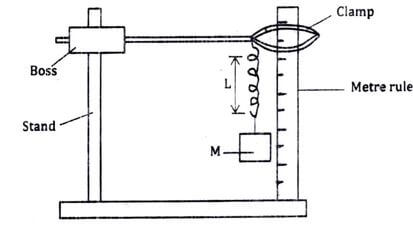
- Measure the length Lo of the unloaded spring. (½ mark)
Lo - ………………………………………. - Attach a mass of 100g on the spring and measure the new length L of the spring. Record this in the table. (5 marks)
Mass (g)
Weight… (N)
L (M)
Е = (L – L0) (M)
K =
100
150
200
- Calculate the change in length е = (L-Lo)m due to the mass of 100g and record in the table.
- Repeat the procedure in (i) - (iv) for mass of 150g and 200g.
- Calculate the value of K given:
K = (w(N))/(e(M)) and find the average value of K.
K Average = (1 mark)
PART B
- Using the same set up as in Part A above, attach the 100g on the spring and support it to stop oscillating.
- Pull the mass through a small distance vertically downwards and release it to make vertical oscillations and record the time for 10 oscillations and determine the periodic time(s).
- Hence complete the table to get T2(S2) and the value of K = (39.49 x M(Kg))/(T2 (S2 ) ) where M = mass used and T2 (S2) is its periodic time (T) squared.
- Table (3/marks)
Mass m(kg)
Time for 10 oscillations t(s)
T (s)
T = t/10
39.49 x M(kg)
T2 (S2)1.00
1.50
2.00
- Find the average value of K (½ mark)
PART C
You are provided with the following:
- A meter rule
- Complete stand
- One 50g mass and a 100g mass
- Three pieces of thread 30cm each.
- Some water in a beaker
- Liquid L in a beaker
- Tissue paper.
Proceed with the experiment as follows:
- Balance the meter rule on the stand and record the reading at this point.
Balance point = ………………………………………………………………(1 mark)
(For the rest of the experiment, the balancing thread must be placed at this position) - Set up the apparatus as shown in the figure 4 below: Use the thread provided to hang the masses such that the positions of the support can be adjusted.
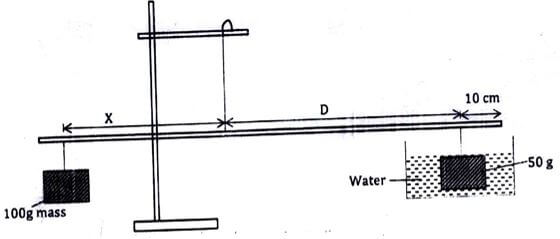
The balance point is attained by adjusting the position of the 100g mass. Note that the distance X and D are measured from the supporting string and the 50g mass is fully submerged in water.
Record the values of
X = ………………………………………………………………………………… (1 mark)
D = ………………………………………………………………………………… (1 mark)
Apply the principle of moments to determine the weight W1 of the 50g mass in water and hence determine the upthrust Uw in water. (2 marks)
W1 = …………………………………………………………………………
Uw = …………………………………………………………………………
Remove the 50g mass from the water and dry it using the tissue paper. - Now changing distance D obtained in (ii) balance the metre rule when the 50g mass is fully immersed in the liquid. Record the new value of the distance X.
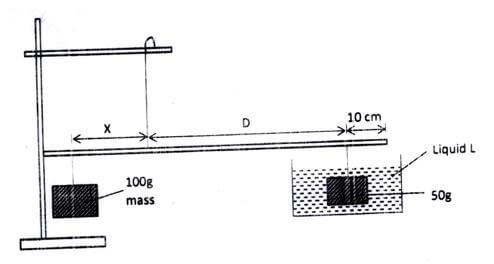
X = …………………………………………………………………………………… (1 mark)
Apply the principle of moments to determine W2 of the 50g mass in the liquid L and hence determine the upthrust UL in the liquid. (2 marks)
W2 = ……………………………………………………
UL = ……………………………………………………… - Determine the relative density R.D of the liquid L given that: (1 mark)
R.D = UL/(Uw ) - Find the density of liquid L in Kg/m3 (1 mark)
QUESTION 2
You are provided with the following apparatus
- Two dry cells and a cell holder
- A voltmeter
- An ammeter (0-1A)
- Potentiometer P
- A bulb and bulb holder
- 7 connecting wires
- 4 crocodile clips
- A switch S
PART A
Set up the circuit as shown below.
Ensure the switch is off.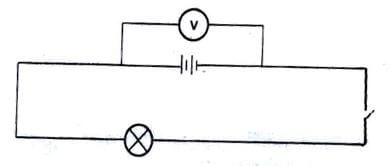
- Record the reading of the voltmeter when the switch is open (1 mark)
V1 ……………………………………………………… - Close the switch and record the voltmeter reading. (1 mark)
V2 …………………………………………………… - Explain the differences in the value of V₂ and V₁ (1 mark)
PART B
- Set up the circuit as shown below.
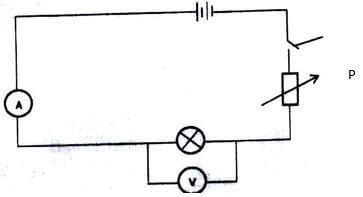
Close the switch S and adjust the potentiometer P till the bulb lights brightest. Record the ammeter and voltmeter reading.
I …………………………………………………………………………………………(½ mark)
V ………………………………………………………………………………………..(½ mark) -
- By adjusting the potentiometer P obtain the corresponding ammeter readings of the values of voltmeter readings given in the table. (4 marks)
Volts (V)
1.5
1.4
1.2
1.0
0.8
0.6
0.4
0.2
Current I (A)
- Plot a graph of voltage against current. (4 marks)
- Determine the resistance of the bulb when voltage is 0.9v. (2 marks)
- Explain the nature of the curve in the graph. (1 mark)
- By adjusting the potentiometer P obtain the corresponding ammeter readings of the values of voltmeter readings given in the table. (4 marks)
PART C
You are provided with the following:
- A lens holder
- Convex lens
- A white screen
- A metre rule
- A candle
Proceed as follows:
- Set up the apparatus as shown in Figure 4

- Starting with u=30 cm, adjust the position of the screen to obtain a sharp image of the candle flame. Record the value of v in Table 3.
Repeat the procedure for u-50 cm. Complete Table 3 (3marks)u (cm
v(cm)
m =
30
50
- Given that the focal length f of the lens satisfies the equation f = v/(m+1), determine the average value of the focal length, f. (2 marks)
MARKING SCHEME
QUESTION 1
Part A
You are provided with the following apparatus.
- Helical spring with pointer.
- One clamp, one stand and one boss
- A stop watch
- One 50g mass
- Two 100g masses
Proceed as follows:
- Suspend the spring vertically alongside a clamped metre rule as shown in the diagram so that the pointer slide along the millimeter scale of the metre rule as shown in the figure below.

- Measure the length Lo of the unloaded spring. (½ mark)
Lo - 40.8cm (At least 1d.p) (use student values. Any length within the metre rule) - Attach a mass of 100g on the spring and measure the new length L of the spring. Record this in the table. (5 marks)
Table
Mass (Kgl
Weight (N)
L(M) ± 0.020
ɵ = (L – L0) (M)
K = w/e (N/M)
100
1.0
0.478
0.07
14.29
150
1.5
0.409
0.139
10.79
200
2.0
0.338
0.21
9.524
- Calculate the change in length е = (L-Lo)m due to the mass of 100g and record in the table.
- Repeat the procedure in (i) - (iv) for mass of 150g and 200g.
- Calculate the value of K given:
K = (w(N))/(e(M)) and find the average value of K.
K Average = (1 mark)
K = w/e (N/M) and find the average value of K
K average = 14.29 + 10.79 + 9.524 - principle of averaging ✔½
3= 11.53 - Evaluation ✔½
(ignore units)
PART B
- Using the same set up as in Part A above, attach the 100g on the spring and support it to stop oscillating.
- Pull the mass through a small distance vertically downwards and release it to make vertical oscillations and record the time for 10 oscillations and determine the periodic time(s).
- Hence complete the table to get T2(S2) and the value of K = (39.49 x M(Kg))/(T2 (S2 ) ) where M = mass used and T2 (S2) is its periodic time (T) squared.
- Table (3/marks)
Mass in (kg)
Time for 10 oscillations t(s)
2 d.p
T(s)
T =(t/10) ±0.2
Exact
T² (S²)
4S +
39.49 X M(Kg)/T² (S²)
4S+
0.10
6.80
0.680
0.4624
8.54
0.15
8.42
0.842
0.7090
8.355
0.20
10.03
1.003
1.006
7.851
- Find the average value of K (½ mark)
K = 8.54 + 8.355 + 7.851
= 8.249 Kgs¯² ✔½
PART C
You are provided with the following:
- A meter rule
- Complete stand
- One 50g mass and a 100g mass
- Three pieces of thread 30cm each.
- Some water in a beaker
- Liquid L in a beaker
- Tissue paper.
Proceed with the experiment as follows:
- Balance the meter rule on the stand and record the reading at this point.
Balance point = 50.0 ± 0.1cm ✔1 1 d.p
(For the rest of the experiment, the balancing thread must be placed at this position) - Set up the apparatus as shown in the figure 4 below: Use the thread provided to hang the masses such that the positions of the support can be adjusted.

The balance point is attained by adjusting the position of the 100g mass. Note that the distance X and D are measured from the supporting string and the 50g mass is fully submerged in water.
Record the values of
X =17.5 ± 1.0cm ✔1 1 d.p is a must
D = 40.0 ± 1.0cm✔1 1 d.p is a must
Apply the principle of moments to determine the weight W1 of the 50g mass in water and hence determine the upthrust Uw in water. (2 marks)
1 x 175 = w1x40 ✔½
W1 = 0.4375n ✔½ Use student value
Uw = 0.5 – 0.4375 = 0.0625N ✔1
Remove the 50g mass from the water and dry it using the tissue paper. - Now changing distance D obtained in (ii) balance the metre rule when the 50g mass is fully immersed in the liquid. Record the new value of the distance X.

X = …………………………………………………………………………………… (1 mark)
Apply the principle of moments to determine W2 of the 50g mass in the liquid L and hence determine the upthrust UL in the liquid. (2 marks)
W2 = 0.4575✔½ W2 X 40 = 1.0 X 18.3
UL = 0.5 - 0.4575 = 0.0425N✔1
- Determine the relative density R.D of the liquid L given that: (1 mark)
R.D = UL/(Uw )
R.D = UL/(Uw ) = 0.0425/0.0625 = 0.68✔1 - Find the density of liquid L in Kg/m3 (1 mark)
ℓL = 0.68 X 1000
= 680Kg/m³✔1
QUESTION 2
You are provided with the following apparatus
- Two dry cells and a cell holder
- A voltmeter
- An ammeter (0-1A)
- Potentiometer P
- A bulb and bulb holder
- 7 connecting wires
- 4 crocodile clips
- A switch S
PART A
Set up the circuit as shown below.
Ensure the switch is off.
- Record the reading of the voltmeter when the switch is open (1 mark)
3.0V ± 0.2 1 d.p ✔1
2.7V ± 0.2 1 d.p✔1
- Close the switch and record the voltmeter reading. (1 mark)
V2 …………………………………………………… - Explain the differences in the value of V₂ and V₁ (1 mark)
Voltage is lost due to internal resistanceS ✔1
PART B
- Set up the circuit as shown below.

Close the switch S and adjust the potentiometer P till the bulb lights brightest. Record the ammeter and voltmeter reading.
I 0.23A ± 0.02 (2 d.p) ✔1
V 2.1 ± 0.2 (1 d.p) ✔1
-
- By adjusting the potentiometer P obtain the corresponding ammeter readings of the values of voltmeter readings given in the table. (4 marks)
Volts (V)
1.5
1.4
1.2
1.0
0.8
0.6
0.4
0.2
Current I (A)
0.20
0.19
0.17
0.16
0.15
0.13
0.12
0.10
- Plot a graph of voltage against current. (4 marks)

- Determine the resistance of the bulb when voltage is 0.9v. (2 marks)
- Explain the nature of the curve in the graph. (1 mark)
- By adjusting the potentiometer P obtain the corresponding ammeter readings of the values of voltmeter readings given in the table. (4 marks)
PART C
You are provided with the following:
- A lens holder
- Convex lens
- A white screen
- A metre rule
- A candle
Proceed as follows:
- Set up the apparatus as shown in Figure 4

- Starting with u=30 cm, adjust the position of the screen to obtain a sharp image of the candle flame. Record the value of v in Table 3.
Repeat the procedure for u-50 cm. Complete Table 3 (3marks)u(cm)
v(cm)
m = v/u
30
30.0
1
50
21.5
0.43
1 d.p ± 2.0 @1 mark
Correct evaluation to 4 s.f or exact - all 1 mark
- Given that the focal length f of the lens satisfies the equation f = v/(m+1), determine the average value of the focal length, f. (2 marks)
- Principle of averaging must be shown ✔1 1 mark
- Correct evaluation to 4 s.f of exact. ✔1 1 mark
- Ignore units
CONFIDENTIAL
INSTRUCTIONS TO SCHOOLS
- The information contained in this paper is to enable the head of school and the teacher in charge of Physics to make adequate preparation for this Physics practical examination. NO ONE ELSE should have access to this paper or acquire knowledge of its contents. Great care MUST be taken to ensure that the information herein does not reach the candidates either directly or indirectly.
- The apparatus required by each candidate for the Physics Practical examination are set out on below. It is expected that the ordinary apparatus of a Physics laboratory will be available.
- The Physics teacher should note that it is his/her responsibility to ensure that each apparatus acquired for this examination agrees with the specifications as indicated on the list of apparatus below.
- The question paper will not be opened in advance.
- The Physics teacher is not expected to perform the experiments.
NB: Any use of apparatus other than the ones specified may lead to candidates being penalized.
QUESTION ONE (EXTRA QUESTION):
- Helical spring with pointer (diameter about 1.2cm, length 7.1 ± 02cm, thickness - 0.60mm)
- One clamp, one stand and one boss
- A Stop watch
- One 50g Mass
- Two 100g masses.
- Metre rule
- Three pieces of thread 30cm each
- Some water in the beaker
- Liquid L (paraffin) in a beaker
- Tissue paper
QUESTIÓN TWO
- An ammeter (0 - 1A)
- A voltmeter (0 - 3 V or 0 - 5V)
- A variable resistor of 100Ω
- A 10Ω carbon resistor
- A piece of resistance wire (SWG 30) 50cm long
- Two New Size D dry cells
- A cell holder
- A switch
- Seven connecting wires of 4 should have crocodile clips both ends and 3 with crocodile clip on one end
- A lens holder
- Convex lens of focal length 15.0cm ± 1 cm
- A white screen
- A Metre rule.
Download Physics Paper 3 Questions, Answers and Confidential - Arise and Shine Mock Exams 2022.
Tap Here to Download for 50/-
Get on WhatsApp for 50/-
Why download?
- ✔ To read offline at any time.
- ✔ To Print at your convenience
- ✔ Share Easily with Friends / Students
